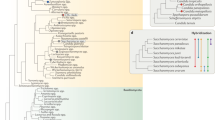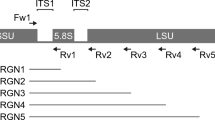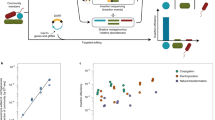Abstract
The definition and delineation of microbial species are of great importance and challenge due to the extent of evolution and diversity. Whole-genome DNA–DNA hybridization is the cornerstone for defining procaryotic species relatedness, but obtaining pairwise DNA–DNA reassociation values for a comprehensive phylogenetic analysis of procaryotes is tedious and time consuming. A previously described microarray format containing whole-genomic DNA (the community genome array or CGA) was rigorously evaluated as a high-throughput alternative to the traditional DNA–DNA reassociation approach for delineating procaryotic species relationships. DNA similarities for multiple bacterial strains obtained with the CGA-based hybridization were comparable to those obtained with various traditional whole-genome hybridization methods (r=0.87, P<0.01). Significant linear relationships were also observed between the CGA-based genome similarities and those derived from small subunit (SSU) rRNA gene sequences (r=0.79, P<0.0001), gyrB sequences (r=0.95, P<0.0001) or REP- and BOX-PCR fingerprinting profiles (r=0.82, P<0.0001). The CGA hybridization-revealed species relationships in several representative genera, including Pseudomonas, Azoarcus and Shewanella, were largely congruent with previous classifications based on various conventional whole-genome DNA–DNA reassociation, SSU rRNA and/or gyrB analyses. These results suggest that CGA-based DNA–DNA hybridization could serve as a powerful, high-throughput format for determining species relatedness among microorganisms.
Similar content being viewed by others
Log in or create a free account to read this content
Gain free access to this article, as well as selected content from this journal and more on nature.com
or
References
Adnan S, Li N, Miura H, Hashimoto Y, Yamamoto H, Ezaki T . (1993). Covalently immobilized DNA plate for luminometric DNA–DNA hybridization to identify viridans streptococci in under 2 h. FEMS Microbiol Lett 106: 139–142.
Amann RI, Lin CH, Key R, Montgomery L, Stahl DA . (1992). Diversity among fibrobacter isolates—towards a phylogenetic classification. Syst Appl Microbiol 15: 23–31.
Behr MA, Wilson MA, Gill WP, Salamon H, Schoolnik GK, Rane S et al. (1999). Comparative genomics of BCG vaccines by whole-genome DNA microarray. Science 284: 1520–1523.
Bodrossy L, Stralis-Pavese N, Murrell JC, Radajewski S, Weilharter A, Sessitsch A . (2003). Development and validation of a diagnostic microbial microarray for methanotrophs. Environ Microbiol 5: 566–582.
Braker G, Zhou JZ, Wu LY, Devol AH, Tiedje JM . (2000). Nitrite reductase genes (nirK and nirS) as functional markers to investigate diversity of denitrifying bacteria in Pacific northwest marine sediment communities. Appl Environ Microbiol 66: 2096–2104.
Brenner DJ, Fanning GR, Rake AV, Johnson KE . (1969). Batch procedure for thermal elution of DNA from hydroxyapatite. Anal Biochem 28: 447–459.
Brutlag DL . (1998). Genomics and computational molecular biology. Curr Opin Microbiol 1: 340–345.
Cardinali G, Liti G, Martini A . (2000). Non-radioactive dot-blot DNA reassociation for unequivocal yeast identification. Int J Syst Evol Microbiol 50: 931–936.
Cho JC, Tiedje JM . (2001). Bacterial species determination from DNA–DNA hybridization by using genome fragments and DNA microarrays. Appl Environ Microbiol 67: 3677–3682.
Cladera AM, Bennasar A, Barcelo M, Lalucat J, Garcia-Valdes E . (2004). Comparative genetic diversity of Pseudomonas stutzeri genomovars, clonal structure, and phylogeny of the species. J Bacteriol 186: 5239–5248.
Cohan FM . (2002). What are bacterial species? Annu Rev Microbiol 56: 457–487.
Crosa JH, Brenner DJ, Falkow S . (1973). Use of a single-strand specific nuclease for analysis of bacterial and plasmid deoxyribonucleic acid homoduplexes and heteroduplexes. J Bacteriol 115: 904–911.
De Lay J, Tijtgat R . (1970). Evaluation of membrane filter methods for DNA–DNA hybridization. Antonie Van Leeuwenhoek J Microbiol 36: 461–474.
DeRisi JL, Iyer VR, Brown PO . (1997). Exploring the metabolic and genetic control of gene expression on a genomic scale. Science 278: 680–686.
Dong YM, Glasner JD, Blattner FR, Triplett EW . (2001). Genomic interspecies microarray hybridization: rapid discovery of three thousand genes in the maize endophyte, Klebsiella pneumoniae 342, by microarray hybridization with Escherichia coli K-12 open reading frames. Appl Environ Microbiol 67: 1911–1921.
Eisen MB, Spellman PT, Brown PO, Botstein D . (1998). Cluster analysis and display of genome-wide expression patterns. Proc Natl Acad Sci USA 95: 14863–14868.
Ezaki T, Hashimoto Y, Yabuuchi E . (1989). Fluorometric deoxyribonucleic acid deoxyribonucleic acid hybridization in microdilution wells as an alternative to membrane-filter hybridization in which radioisotopes are used to determine genetic relatedness among bacterial strains. Int J Syst Bacteriol 39: 224–229.
Gade D, Schlesner H, Glockner FO, Amann R, Pfeiffer S, Thomm A . (2004). Identification of planctomycetes with order-, genus-, and strain-specific 16S rRNA-targeted probes. Microb Ecol 47: 243–251.
Gao HC, Wang Y, Liu XD, Yan TF, Wu LY, Alm E et al. (2004). Global transcriptome analysis of the heat shock response of Shewanella oneidensis. J Bacteriol 186: 7796–7803.
Garrity GM, Bell JA, Lilburn TG . (2004). Taxonomic outline of the Prokaryotes. In: Boone DR, Castenholz RW, Garrity GM (eds). Bergey's Manual of Systematic Bacteriology. Springer: Berlin, Heidelberg, New York, pp 163–164.
Goris J, Suzuki K, De Vos P, Nakase T, Kersters K . (1998). Evaluation of a microplate DNA–DNA hybridization method compared with the initial renaturation method. Can J Microbiol 44: 1148–1153.
Harayama S, Kasai H . (2006). Bacterial phylogeny reconstruction from molecular sequences. In: Stackebrandt E (ed). Molecular Identification, Systematics, and Population Structure of Prokaryotes. Springer: New York, pp 105–140.
Holmes DE, Nevin KP, Lovley DR . (2004). Comparison of 16S rRNA, nifD, recA, gyrB, rpoB and fusA genes within the family Geobacteraceae fam. nov. Int J Syst Evol Microbiol 54: 1591–1599.
Kato-Maeda M, Rhee JT, Gingeras TR, Salamon H, Drenkow J, Smittipat N et al. (2001). Comparing genomes within the species Mycobacterium tuberculosis. Genome Res 11: 547–554.
Kaznowski A . (1995). A method of colorimetric DNA–DNA hybridization in microplates with covalently immobilized DNA for identification of Aeromonas spp. Med Microbiol Lett 4: 362–369.
Konstantinidis KT, Tiedje JM . (2004). Trends between gene content and genome size in prokaryotic species with larger genomes. Proc Natl Acad Sci USA 101: 3160–3165.
Konstantinidis KT, Tiedje JM . (2007). Prokaryotic taxonomy and phylogeny in the genomic era: advancements and challenges ahead. Curr Opin Microbiol 10: 504–509.
Kumar S, Tamura K, Nei M . (2003). MEGA3: an integrated software for molecular evolutionary genetic analysis and sequence alignment. Integr Comp Biol 43: 947.
Liu YQ, Zhou JZ, Omelchenko MV, Beliaev AS, Venkateswaran A, Stair J et al. (2003). Transcriptome dynamics of Deinococcus radiodurans recovering from ionizing radiation. Proc Natl Acad Sci USA 100: 4191–4196.
Lockhart DJ, Dong HL, Byrne MC, Follettie MT, Gallo MV, Chee MS et al. (1996). Expression monitoring by hybridization to high-density oligonucleotide arrays. Nat Biotechnol 14: 1675–1680.
Loy A, Lehner A, Lee N, Adamczyk J, Meier H, Ernst J et al. (2002). Oligonucleotide microarray for 16S rRNA gene-based detection of all recognized lineages of sulfate-reducing prokaryotes in the environment. Appl Environ Microbiol 68: 5064–5081.
Maeda Y, Shinohara H, Kiba A, Ohnishi K, Furuya N, Kawamura Y et al. (2006). Phylogenetic study and multiplex PCR-based detection of Burkholderia plantarii, Burkholderia glumae and Burkholderia gladioli using gyrB and rpoD sequences. Int J Syst Evol Microbiol 56: 1031–1038.
Mehlen A, Goeldner M, Ried S, Stindl S, Ludwig W, Schleifer KH . (2004). Development of a fast DNA–DNA hybridization method based on melting profiles in microplates. Syst Appl Microbiol 27: 689–695.
Murray AE, Lies D, Li G, Nealson K, Zhou J, Tiedje JM . (2001). DNA/DNA hybridization to microarrays reveals gene-specific differences between closely related microbial genomes. Proc Natl Acad Sci USA 98: 9853–9858.
Palleron NJ, Doudorof M, Stanier RY, Solanes RE, Mandel M . (1970). Taxonomy of aerobic pseudomonads—properties of Pseudomonas-stutzeri group. J Gen Microbiol 60: 215–231.
Popoff M, Coynault C . (1980). Use of deae-cellulose filters in the s1 nuclease method for bacterial deoxyribonucleic-acid hybridization. Ann Microbiol A 131: 151–155.
Rademaker JLW, Hoste B, Louws FJ, Kersters K, Swings J, Vauterin L et al. (2000). Comparison of AFLP and rep-PCR genomic fingerprinting with DNA–DNA homology studies: Xanthomonas as a model system. Int J Syst Evol Microbiol 50: 665–677.
Rhee SK, Liu XD, Wu LY, Chong SC, Wan XF, Zhou JZ . (2004). Detection of genes involved in biodegradation and biotransformation in microbial communities by using 50-mer oligonucleotide microarrays. Appl Environ Microbiol 70: 4303–4317.
Rodrigues JLM, Silva-Stenico ME, Gomes JE, Lopes JRS, Tsai SM . (2003). Detection and diversity assessment of Xylella fastidiosa in field-collected plant and insect samples by using 16S rRNA and gyrB sequences. Appl Environ Microbiol 69: 4249–4255.
Rossello R, Garciavaldes E, Lalucat J, Ursing J . (1991). Genotypic and phenotypic diversity of Pseudomonas-stutzeri. Syst Appl Microbiol 14: 150–157.
Rossello-Mora R . (2006). DNA–DNA reassociation methods applied to microbial taxonomy and their critical evaluation. In: Stackebrandt E (ed). Molecular Identification, Systematics, and Population Structure of Prokaryotes. Springer Verlag: Berlin, Heidelberg, New York, pp 23–50.
Rossello-Mora R, Amann R . (2001). The species concept for prokaryotes. Fems Microbiol Rev 25: 39–67.
Salama N, Guillemin K, McDaniel TK, Sherlock G, Tompkins L, Falkow S . (2000). A whole-genome microarray reveals genetic diversity among Helicobacter pylori strains. Proc Natl Acad Sci USA 97: 14668–14673.
Schadt CW, Liebich J, Chong SC, Gentry TJ, He ZL, Pan HB et al. (2005). Design and use of functional gene microarrays (FGAs) for the characterization of microbial communities. In: Savidge T, Pothulakis C (eds). Microbial Imaging. Elsevier Academic Press: Amsterdam, pp 331–368.
Schena M, Davis RW . (2000). Technology standards for microarray research. In: Schena M (ed). Microarray Biochip Technology. Eaton Publishing: Natick, pp 301–306.
Schena M, Shalon D, Davis RW, Brown PO . (1995). Quantitative monitoring of gene-expression patterns with a complementary-DNA Microarray. Science 270: 467–470.
Schena M, Shalon D, Heller R, Chai A, Brown PO, Davis RW . (1996). Parallel human genome analysis: microarray-based expression monitoring of 1000 genes. Proc Natl Acad Sci USA 93: 10614–10619.
Sepulveda-Torres LD, Zhou JZ, Guasp C, Lalucat J, Knaebel D, Plank JL et al. (2001). Pseudomonas sp strain KC represents a new genomovar within Pseudomonas stutzeri. Int J Syst Evol Microbiol 51: 2013–2019.
Song B, Haggblom MM, Zhou JZ, Tiedje JM, Palleroni NJ . (1999). Taxonomic characterization of denitrifying bacteria that degrade aromatic compounds and description of Azoarcus toluvorans sp nov and Azoarcus toluclasticus sp nov. Int J Syst Bacteriol 49: 1129–1140.
Stackebrandt E . (2006). Exciting times: the challenge to be a baterial systematist. In: Stackebrandt E (ed). Molecular Identification, Systematics, and Population Structure of Prokaryotes. Springer: New York, pp 1–16.
Stackebrandt E, Frederiksen W, Garrity GM, Grimont PAD, Kampfer P, Maiden MCJ et al. (2002). Report of the ad hoc committee for the re-evaluation of the species definition in bacteriology. Int J Syst Evol Microbiol 52: 1043–1047.
Stackebrandt E, Goebel BM . (1994). A Place for DNA–DNA reassociation and 16 s ribosomal-RNA sequence-analysis in the present species definition in bacteriology. Int J Syst Bacteriol 44: 846–849.
Stapleton RD, Sabree ZL, Palumbo AV, Moyer CL, Devol AH, Roh Y et al. (2005). Metal reduction at cold temperatures by Shewanella isolates from various marine environments. Aquat Microb Ecol 38: 81–91.
Thompson JD, Higgins DG, Gibson TJ . (1994). Clustal-W—improving the sensitivity of progressive multiple sequence alignment through sequence weighting, position-specific gap penalties and weight matrix choice. Nucleic Acids Res 22: 4673–4680.
Tiquia SM, Wu LY, Chong SC, Passovets S, Xu D, Xu Y et al. (2004). Evaluation of 50-mer oligonucleotide arrays for detecting microbial populations in environmental samples. Biotechniques 36: 664–670.
Tourova TP . (2000). The role of DNA–DNA hybridization and 16S rRNA gene sequencing in solving taxonomic problems by the example of the order Haloanaerobiales. Microbiology 69: 623–634.
Venkateswaran K, Moser DP, Dollhopf ME, Lies DP, Saffarini DA, MacGregor BJ et al. (1999). Polyphasic taxonomy of the genus Shewanella and description of Shewanella oneidensis sp. nov. Int J Syst Bacteriol 49: 705–724.
Venter JC, Remington K, Heidelberg JF, Halpern AL, Rusch D, Eisen JA et al. (2004). Environmental genome shotgun sequencing of the Sargasso Sea. Science 304: 66–74.
Verdnik D, Handran S, Pickett S . (2002). Key considerations for accurate microarray scanning and image analysis. In: Shah GKaS (ed). DNA Array Image Analysis Nuts and Bolts. DNA Press: Eagleville, PA, pp 83–98.
Versalovic J, Schneider M, de Bruijn FJ, Lupski JR . (1994). Genomic fingerprinting of bacteria using repetitive sequence-based polymerase chain reaction. Methods Mol Cell Biol 5: 25–40.
Wayne LG, Brenner DJ, Colwell RR, Grimont PAD, Kandler O, Krichevsky MI et al. (1987). Report of the ad hoc committee on reconciliation of approaches to bacterial systematics. Int J Syst Bacteriol 37: 463–464.
Whitman WB, Coleman DC, Wiebe WJ . (1998). Prokaryotes: the unseen majority. Proc Natl Acad Sci USA 95: 6578–6583.
Wu LY, Thompson DK, Li GS, Hurt RA, Tiedje JM, Zhou JZ . (2001). Development and evaluation of functional gene arrays for detection of selected genes in the environment. Appl Environ Microbiol 67: 5780–5790.
Wu LY, Thompson DK, Liu XD, Fields MW, Bagwell CE, Tiedje JM et al. (2004). Development and evaluation of microarray-based whole-genome hybridization for detection of microorganisms within the context of environmental applications. Environ Sci Technol 38: 6775–6782.
Yamamoto S, Bouvet PJM, Harayama S . (1999). Phylogenetic structures of the genus Acinetobacter based on gyrB sequences: comparison with the grouping by DNA–DNA hybridization. Int J Syst Bacteriol 49: 87–95.
Yamamoto S, Harayama S . (1995). PCR amplification and direct sequencing of gyrB genes with universal primers and their application to the detection and taxonomic analysis of pseudomonas-putida strains. Appl Environ Microbiol 61: 1104–1109.
Yamamoto S, Harayama S . (1996). Phylogenetic analysis of Acinetobacter strains based on the nucleotide sequences of gyrB genes and on the amino acid sequences of their products. Int J Syst Bacteriol 46: 506–511.
Yamamoto S, Harayama S . (1998). Phylogenetic relationships of Pseudomonas putida strains deduced from the nucleotide sequences of gyrB, ropD and 16S rRNA genes. Int J Syst Bacteriol 48: 813–819.
Yan TF, Fields MW, Wu LY, Zu YG, Tiedje JM, Zhou JZ . (2003). Molecular diversity and characterization of nitrite reductase gene fragments (nirK and nirS) from nitrate- and uranium-contaminated groundwater. Environ Microbiol 5: 13–24.
Ye RW, Tao W, Bedzyk L, Young T, Chen M, Li L . (2000). Global gene expression profiles of Bacillus subtilis grown under anaerobic conditions. J Bacteriol 182: 4458–4465.
Zhang L, Hurek T, Reinhold-Hurek B . (2007). A nifH-based oligonucleotide microarray for functional diagnostics of nitrogen-fixing microorganisms. Microb Ecol 53: 456–470.
Zhou JH . (2003). Microarrays for bacterial detection and microbial community analysis. Curr Opin Microbiol 6: 288–294.
Zhou JZ, Fries MR, Cheesanford JC, Tiedje JM . (1995). Phylogenetic analyses of a new group of denitrifiers capable of anaerobic growth on toluene and description of Azoarcus tolulyticus sp. nov. Int J Syst Bacteriol 45: 500–506.
Ziemke F, Hofle MG, Lalucat J, Rossello-Mora R . (1998). Reclassification of Shewanella putrefaciens Owen's genomic group II as Shewanella baltica sp. nov. Int J Syst Bacteriol 48: 179–186.
Acknowledgements
This research was supported by The United States Department of Energy under Genomics: GTL program through the Virtual Institute of Microbial Stress and Survival (VIMSS; http://vimss.lbl.gov), and the Environmental Remediation Science Program (ERSP), and was supported by Oklahoma Center for the Advancement of Science and Technology under Oklahoma Applied Research Support Program. A part of XL's efforts was supported by Chinese National Science Foundation (NSFC) Joint Research Fund for Overseas Chinese Young Scholars (30428014), NSFC Fund for Creative Research (code 50321402) and Chinese National Basic Research (2004CB619201).
Author information
Authors and Affiliations
Corresponding author
Additional information
Supplementary Information accompanies the paper on The ISME Journal website (http://www.nature.com/ismej)
Supplementary information
Rights and permissions
About this article
Cite this article
Wu, L., Liu, X., Fields, M. et al. Microarray-based whole-genome hybridization as a tool for determining procaryotic species relatedness. ISME J 2, 642–655 (2008). https://doi.org/10.1038/ismej.2008.23
Received:
Revised:
Accepted:
Published:
Issue date:
DOI: https://doi.org/10.1038/ismej.2008.23



